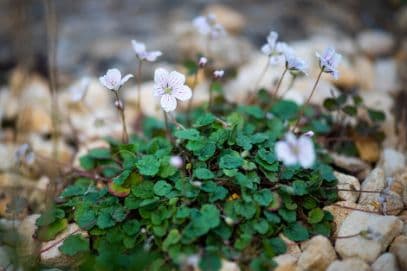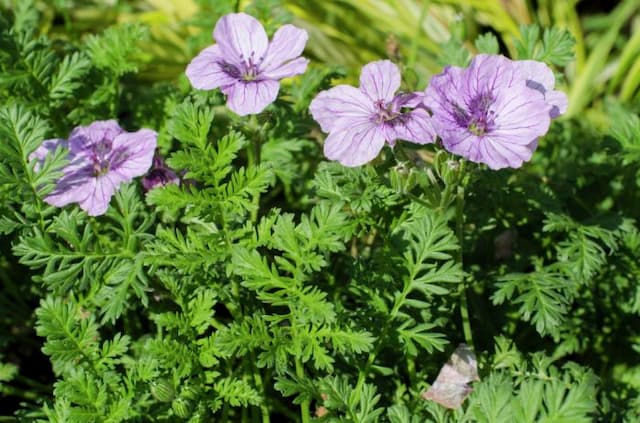Scented Geranium Pelargonium 'Brian West Butterfly' (Z/st)

ABOUT
The Pelargonium 'Brian West Butterfly', commonly known as the butterfly geranium, is a particularly striking plant due to its distinctive foliage and flowers. The leaves of this plant are usually rounded, with a soft, velvety texture and often exhibit a zonal pattern, which can be seen as darker colored zones or bands on the leaves. This variegation adds an ornamental appeal to the plant even when it is not in bloom. The flowers of the butterfly geranium are what truly set it apart. They typically have a unique form that resembles butterflies, with petals that are ruffled or frilled, giving them a delicate and intricate appearance. The blossoms come in a variety of vibrant colors, which might include shades of pink, red, purple, or white, often with contrasting and eye-catching markings or streaks. These markings enhance their resemblance to the wings of butterflies. Furthermore, the petals often have two upper petals that are larger and stand upright, while the three lower petals are smaller and may be spread out or hang down. This arrangement contributes to the butterfly-like visage of the flowers. The plant's blooms are often clustered together in umbel-like inflorescences, making a showy display that attracts a lot of attention in a garden setting. Adding to its ornamental features, the butterfly geranium is known for its long blooming period, making it a beloved choice for continuous color in plantings, pots, or as a standalone specimen. With proper care, it keeps producing these enchanting blooms for an extended period.
About this plant
 Names
NamesFamily
Geraniaceae
Synonyms
Brian West Butterfly Geranium, Butterfly Pelargonium
Common names
Pelargonium 'Brian West Butterfly' (Z/st).
 Toxicity
ToxicityTo humans
Geraniums, including the Pelargonium 'Brian West Butterfly', are not known to be highly toxic to humans. However, ingestion can potentially cause mild irritation to the mouth, throat, or stomach, leading to symptoms like nausea, vomiting, or diarrhea. It's generally a good idea to avoid eating parts of ornamental plants due to potential adverse effects.
To pets
Geraniums can be toxic to pets, especially cats and dogs, if ingested. The toxicity of Pelargonium 'Brian West Butterfly' for pets may result in symptoms such as vomiting, anorexia, depression, and dermatitis. Cats may also experience lethargy and ataxia. It's important to keep geraniums out of reach of pets to prevent poisoning. If you suspect your pet has ingested geraniums, consult a veterinarian immediately.
 Characteristics
CharacteristicsLife cycle
Perennials
Foliage type
Evergreen
Color of leaves
Green
Flower color
Mixed
Height
1-2 feet (30-60 cm)
Spread
1-2 feet (30-60 cm)
Plant type
Herb
Hardiness zones
10
Native area
South Africa
Benefits
 General Benefits
General Benefits- Attracts Pollinators: Pelargonium 'Brian West' is known to attract bees and butterflies, which can help pollinate other plants in the garden.
- Low Maintenance: This variety of geranium is relatively easy to care for, requiring minimal attention once established.
- Drought Tolerant: It is quite resilient in dry conditions, making it suitable for gardens in arid climates or areas with water restrictions.
- Adds Color: The butterfly-patterned blooms provide a vibrant splash of color, enhancing the aesthetic appeal of garden spaces.
- Long Blooming Season: It has a particularly long flowering period, which means more color in the garden for an extended time.
- Container Gardening: The plant is well-suited to being grown in pots, making it versatile for balconies and patios.
- Landscape Design: The unique butterfly-like flowers can serve as an excellent focal point or complement in landscape design.
 Medical Properties
Medical PropertiesThis plant is not used for medical purposes.
 Air-purifying Qualities
Air-purifying QualitiesThis plant is not specifically known for air purifying qualities.
 Other Uses
Other Uses- Craft Projects: The vibrant petals of the geranium can be pressed and used in scrapbooking or to create natural, floral art pieces.
- Scented Oils: Geranium leaves can be infused into oils to create custom, naturally scented products for home fragrance or perfumery uses.
- Culinary Garnish: Edible flowers like those of the geranium can add a splash of color and a sense of elegance when used to garnish desserts and cocktails.
- Natural Fabric Dyes: The flowers and leaves, especially when crushed, can be used to naturally dye fabrics with shades of pink, red, or green.
- Plant-based Insect Repellent: Growing geraniums around the home may help to repel insects naturally due to certain compounds they contain.
- Feline Deterrent: The scent of geraniums is known to be unappealing to cats, so planting them can help to keep cats away from certain areas.
- Floral Bath Infusions: Geranium petals can be sprinkled into bathwater for a floral, aromatic bathing experience.
- Scented Bookmarks: Dry and press the flowers to create aromatic bookmarks that release a mild fragrance when tucked inside books or stationery.
- Colorful Compost Material: Geranium plant matter can be added to compost bins as a source of organic material that will break down and enrich soil.
- Natural Potpourri: Dried geranium flowers and leaves can be mixed with other botanicals to create a homemade potpourri for freshening up rooms.
Interesting Facts
 Feng Shui
Feng ShuiThe plant_name is not used in Feng Shui practice.
 Zodiac Sign Compitability
Zodiac Sign CompitabilityThe plant_name is not used in astrology practice.
 Plant Symbolism
Plant Symbolism- Transformation - The 'Butterfly' part of the name suggests a symbol of change and transformation, reminiscent of how a butterfly emerges from its chrysalis.
- Beauty - Pelargoniums are widely appreciated for their aesthetic appeal, signifying the appreciation of natural beauty.
- Survival - As a hardy plant, the Pelargonium represents resilience and the ability to thrive in various conditions, reflecting the human capacity to endure challenges.
- Positive Energy - With its bright and colorful flowers, the plant is often thought to radiate positivity, uplifting spirits in its presence.
- Balancing Emotions - In aromatherapy, scented Pelargoniums are used to help balance the mind and emotions, symbolizing emotional stability and calm.
 Water
WaterTo properly water a Geranium, also known as a Pelargonium 'Brian West Butterfly', it is essential to let the top inch of soil dry out between waterings, which typically means watering about once a week. In hotter and drier conditions, you may need to water more frequently, while in cooler, damp conditions, less often. Use lukewarm water and aim to moisten the soil thoroughly until water runs out of the drainage holes, indicating the roots have received sufficient moisture. Depending on the size of the plant and the pot, this could mean using approximately 16 to 32 ounces of water for a standard indoor pot every seven days. Adjust the amount of water and frequency to the plant's response and seasonal changes.
 Light
LightGeraniums, such as Pelargonium 'Brian West Butterfly', thrive in bright, indirect sunlight. They should be placed in a location where they can receive at least six hours of sunlight daily, such as near a south or west-facing window. Direct midday sun in the peak of summer can sometimes be too intense, so a spot that offers some shade or diffused light during the hottest part of the day is ideal.
 Temperature
TemperatureGeraniums, or Pelargonium 'Brian West Butterfly', prefer to be kept in a temperature range between 65 and 75 degrees Fahrenheit. They can tolerate minimum temperatures down to about 55 degrees Fahrenheit at night but should not be exposed to temperatures below 30 degrees Fahrenheit as they are not frost-hardy. The ideal temperature will keep the plant thriving without putting stress on it due to excessive cold or heat.
 Pruning
PruningPruning Geraniums, like Pelargonium 'Brian West Butterfly', is important to promote bushy growth and to remove any dead or yellowing leaves. Do this periodically throughout the growing season, focusing on pinching off spent blooms and cutting back leggy stems to encourage new growth. The best time for a more extensive pruning is in late winter or early spring before new growth begins. Pruning annually helps maintain an attractive shape and size and rejuvenates the plant for the coming season.
 Cleaning
CleaningAs needed
 Soil
SoilFor a Pelargonium, commonly known as a geranium, the best soil mix is one that provides good drainage and aeration. A mixture of two parts peat moss, one part perlite or coarse sand, and one part potting soil works well. It's also important to maintain a soil pH between 6.0 and 7.0 for optimal growth.
 Repotting
RepottingGeraniums should generally be repotted every one to two years or when the plant has outgrown its current pot. It’s best to repot in spring before new growth begins.
 Humidity & Misting
Humidity & MistingGeraniums prefer moderate humidity levels around 40-60%. They do not thrive in excessively humid environments as it can encourage fungal diseases.
 Suitable locations
Suitable locationsIndoor
Place in bright, indirect light and rotate for even growth.
Outdoor
Plant in full sun to light shade in well-draining soil.
Hardiness zone
10-11 USDA
 Life cycle
Life cycleThe common name for Pelargonium 'Brian West Butterfly' is Geranium 'Brian West Butterfly'. The life cycle begins with seed germination, where the seeds require warm temperatures and consistent moisture to sprout. The seedlings then develop into young plants, establishing a small rosette of leaves and a root system. As the plant matures, it enters the vegetative stage, producing lush foliage and stems, preparing for the flowering phase. During the flowering stage, the plant displays its characteristic butterfly-like blooms which can last for several weeks, attracting pollinators. After pollination, the plant produces seeds, completing the cycle, and may enter a period of dormancy in cooler climates before resprouting in the spring.
 Propogation
PropogationPropogation time
Spring-Early Summer
Propogation: The Pelargonium 'Brian West Butterfly', commonly known as Geranium, is typically propagated through stem cuttings. This method is most successful during the growing season, which is spring and summer. To propagate Geraniums via stem cuttings, select a healthy, non-flowering stem and cut it to about 4 to 6 inches (10 to 15 centimeters) long. Remove the leaves from the bottom half of the cutting and dip the cut end into rooting hormone to encourage root growth. Plant the cutting in a pot filled with moist, well-draining potting mix, ensuring the lower leaf nodes are buried. Place the pot in a warm, bright location out of direct sunlight and keep the soil consistently moist until roots have established, which can take several weeks. Once the cutting has rooted and shows signs of new growth, it can be transplanted into its final location.




![Cranesbill [Blue Sunrise]](/_next/image?url=https%3A%2F%2Fplants-admin.emdemapps.com%2Fimages%2Fplants%2F%2Fimages%2F604b638d45948.png&w=640&q=75)




